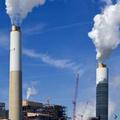 美國布希政府原本打算修改空氣清淨法兩項條款,允許發電廠等污染製造者增加煙霧和塵灰污染,不過,目前他們已決定中斷這項修法計畫。
美國布希政府原本打算修改空氣清淨法兩項條款,允許發電廠等污染製造者增加煙霧和塵灰污染,不過,目前他們已決定中斷這項修法計畫。
第一項條款關係到空氣清淨法案新污染源審查條例,原修法計畫將允許燃煤發電廠得以擴充機組以增加發電量,卻不需要加裝新的污染控制設備。
第二項被廢止的修法計畫是針對國會通過的國家公園及荒野地區保護條款,一旦修法成功,將會削弱特殊空氣品質保護,讓業者更容易在國家公園附近興建燃煤發電廠、精鍊廠或工廠。
這兩項修法計畫之前已面臨公共衛生和環境團體、州及地區性空氣品質管理機構與國會議員的反對。
環保署官員曾嘗試在2009年1月20日歐巴馬宣誓上任總統前完成這兩項進行多年的議題。
清淨空氣機構全國聯會(National Association of Clear Aire Agencies)執行長貝克(Bill Becker)表示:「環保署決定重新考慮這項有嚴重瑕疵的空污法規,是一個正確的選擇。否則,修法通過的話,美國每個發電廠都不必引進現代污染控制技術。」
但是環保署10日仍針對一項條款定案:讓一些主要業者計算污染排放量之時,可不必計算「散逸性排放」(fugitive emissions),藉此讓業者規避《新污染源審查條例》中規範的「應加裝新控制設備之排放底限」。
散逸性排放為非由儲存設備或排氣孔釋放到空氣中的污染,通常是因為設備氣體洩漏、揮發過程或是風吹影響。
貝克表示:「環保署制訂散逸性排放的相關規定,將會允許其他主要工業設施,包括礦業工程和酒精製造廠能夠規避重要的環保要求。」
受影響的行業包括電力服務、石油煉製工業、化工產品、紙漿和造紙業 。
The Bush administration has dropped plans to adopt two Clean Air Act rules that would have allowed power plants and other polluters to increase smog and soot pollution.
The first rule concerned the Clean Air Act's New Source Review program. It would have allowed coal-fired power plants to increase their power output by installing new equipment without adopting pollution controls.
The second abandoned rule would have weakened special air quality protections that Congress adopted for national parks and wilderness areas. If the rule had been adopted, it would have been easier to build a coal-fired power plant, refinery or factory near a national park.
Both rules had faced opposition from public health and environmental groups, state and local air quality regulators, and prominent members of Congress.
EPA officials had been trying to finalize both proposals before President-elect Barack Obama is sworn in January 20. The have both been in the works for years.
"EPA’s decision to reconsider issuing a severely deficient air pollution rule that would have exempted almost every power plant in this country from installing modern pollution control technology is the correct one," said Bill Becker, executive director of the National Association of Clean Air Agencies.
However, the EPA Wednesday finalized a rule that exempts "fugitive emissions" from being counted for some major industries in determining whether emissions sources making modifications to their facilities trigger New Source Review requirements.
Fugitive emissions are pollutants released to the air other than those from stacks or vents. They are often due to equipment leaks, evaporative processes, and windblown disturbances.
Becker said," the agency has finalized another rule today on fugitive emissions that allows other major industrial facilities such as mining operations and ethanol production plants, to escape these important requirements."
Affected industries include electric services, petroleum refining, industrial chemical products, and pulp and paper mills.


